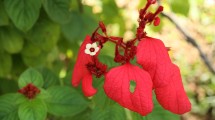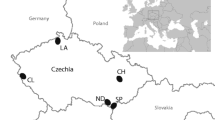Abstract
The foraging behavior of a cryptic romaleine grasshopper was observed in its natural habitat in southern Arizona. Individual polyphagy, dietary mixing, and the pattern of feeding on different substrates were monitored. Individuals were found to be extreme generalists with surprising levels of feeding on other insects. Differences in the foraging behavior between grasshopper species are discussed in relation to the habitat, the season, and the different defensive strategies.
Similar content being viewed by others
References
Barnes, O. L. (1955). Effects of food plants on the lesser migratory grasshopper.J. Econ. Entomol. 48(2): 119–124.
Bernays, E. A. (1993). Aversion learning and feeding. In Papaj, D. R., and Lewis, A. C. (eds.),Insect Learning, Chapman and Hall, New York, pp. 1–17.
Bernays, E. A., and Bright, K. L. (1993). Mechanisms of dietary mixing in grasshoppers: A review.Comp. Biochem. Physiol. A104 125–131.
Bernays, E. A., and Chapman, R. F. (1978). Plant chemicals and Acridoid feeding behavior. In Harborne, J. B. (ed.),Biochemical Aspects of Plant and Animal Coevolution, Academic Press, London, pp. 99–141.
Bernays, E. A., and Simpson, S. J. (1990). Nutrition. In Chapman, R. F., and Joem, A. (eds.),Biology of Grasshoppers, Wiley, New York, pp. 105–127.
Bernays, E. A., Bright, K. L., Howard, J. J., Raubenheimer, D., and Champagne, D. (1992). Variety is the spice of life: Frequent switching between foods in the polyphagous grasshopperTaeniopoda eques Burmeister (Orthoptera: Acrididae).Anim. Behav. 44 721–731.
Blaney, W. M., Chapman, R. F., and Wilson, A. (1973). The pattern of feeding ofLocusta migratoria (Orthoptera: Acrididae).Acrida 2 119–137.
Blum, M. S., Severson, R. F., Arrendale, R. F., Whitman, D. W., Escoubas, P., Adeyeye, O., and Jones, C. G. (1990). A generalist herbivore in a specialist mode.J. Chem. Ecol. 16 223–244.
Champagne, D., and Bernays, E. A. (1991). The importance of an inadequate sterol profile in food aversion learning in grasshoppers.Physiol. Entomol. 16 391–400.
Chapman, R. F. (1990). Food selection. In Chapman, R. F., and Joern, A. (eds.),Biology of Grasshoppers, Wiley, New York, pp. 39–72.
Chapman, R. F., and Beerling, E. A. M. (1990). The pattern of feeding of first instar nymphs ofSchistocerca americana.Physiol. Entomol. 15 1–12.
Chappell, M. A., and Whitman, D. W. (1990). Grasshopper thermoregulation. In Chapman, R. F., and Joern, A. (eds.),Biology of Grasshoppers, Wiley, New York, pp. 143–172.
Freeland, W. J., and Janzen, D. (1974). Strategies in herbivory by mammals: the role of secondary plant compounds.Am. Nat. 108 269–289.
Joern, A., Mitschler, R., and O'Leary, H. (1986). Activity and time budgets of three grasshopper species (Orthoptera, Acrididae) from a sandhills grassland.J. Kans. Entomol. Soc. 59 1–6.
Jones, C. G., Hess, T. A., Whitman, D. W., Silk, P. J., and Blum, M. S. (1986). Idiosyncratic variation in chemical defenses among individual generalist grasshoppers.J. Chem. Ecol. 12 749–761.
Kearney, T. H., Peebler, R. H.,et al. (1969).Arizona Flora (2nd ed., supplement by Howell, J. T., McClintock, E.,et al.), University of California Press, Berkeley.
Lee, J. C. (1991).Learning and Food Selection in Polyphagous Insects, Ph.D. thesis, University of California, Berkeley.
Lee, J. C., and Bernays, E. A. (1988). Declining acceptability of a food plant for the polyphagous grasshopperSchistocerca americana: The role of food aversion learning.Physiol. Entomol. 13 291–301.
MacFarlane, J. H., and Thorsteinson, A. J. (1980). Development and survival of the two-striped grasshopper,Melanoplus bivittatus (Say) (Orthoptera: Acrididae) on various single and multiple plant diets.Acrida 9 63–76.
Mulkern, G. B., Pruess, K. P., Knutson, H., Campbell, J. B., and Lambley, J. D. (1969). Food habits and preferences of grassland grasshoppers of the North Central Great Plains. North Central Regional Publication No. 196, Bulletin No. 481, Agriculture Experiment Station, North Dakota State University, Fargo.
Raubenheimer, D., and Bernays, E. A. (1993). Patterns of feeding in the polyphagous grasshopperTaeniopoda eques: A field study.Anim. Behav. 45 153–167.
Simpson, S. J. (1982). Changes in the efficiency of utilisation of food throughout the fifth-instar nymphs ofLocusta migratoria.Entomol. Exp. Appl. 31 265–275.
Simpson, S. J., and Raubenheimer, D. (1993). The central role of the haemolymph in the regulation of nutrient intake in insects.Physiol. Entomol. 18 395–403.
Simpson, S. J., and Simpson, C. L. (1990). The mechanisms of nutritional compensation by phytophagous insects. In Bernays, E. A. (ed.),Insect-Plant Interactions, Vol. 2, CRC Press, Boca Raton, FL, pp. 111–160.
Slater, P. J. B. (1974). The temporal pattern of feeding in the zebra finch.Anim. Behav. 22 506–515.
Uvarov, B. P. (1966).Grasshoppers and Locusts, Vol. 1, Anti-Locust Research Centre, London.
Waldbauer, G., and Friedman, S. (1991). Self-selection of optimal diets by insects.Annu. Rev. Entomol. 36 43–64.
Whitman, D. W. (1990). Grasshopper chemical communication. In Chapman, R. F., and Joern, A. (eds.),Biology of Grasshoppers, Wiley-Interscience, New York, pp. 357–391.
Whitman, D. W., Blum, M. S., and Jones, C. G. (1985). Chemical defense inTaeniopoda eques (Orthoptera: Acrididae): Role of the metathoracic secretion.Ann. Entomol. Soc. Am. 78 451–455.
Whitman, D. W., and Orsak, L. J. (1985). Biology ofTaeniopoda eques (Orthoptera: Acrididae) in southeastern Arizona.Ann. Entomol. Soc. Am. 78 811–825.
Author information
Authors and Affiliations
Rights and permissions
About this article
Cite this article
Bright, K.L., Bernays, E.A. & Moran, V.C. Foraging patterns and dietary mixing in the field by the generalist grasshopperBrachystola magna (Orthoptera: Acrididae). J Insect Behav 7, 779–793 (1994). https://doi.org/10.1007/BF01997126
Accepted:
Issue Date:
DOI: https://doi.org/10.1007/BF01997126




